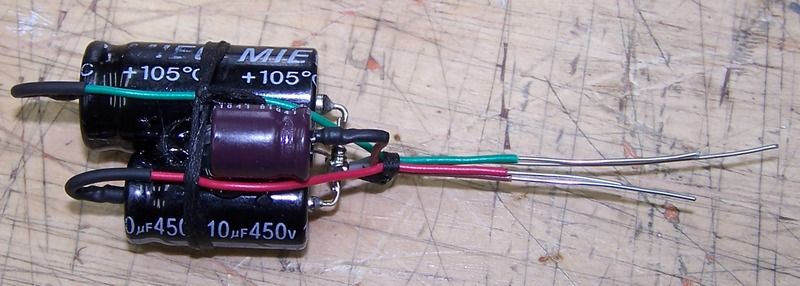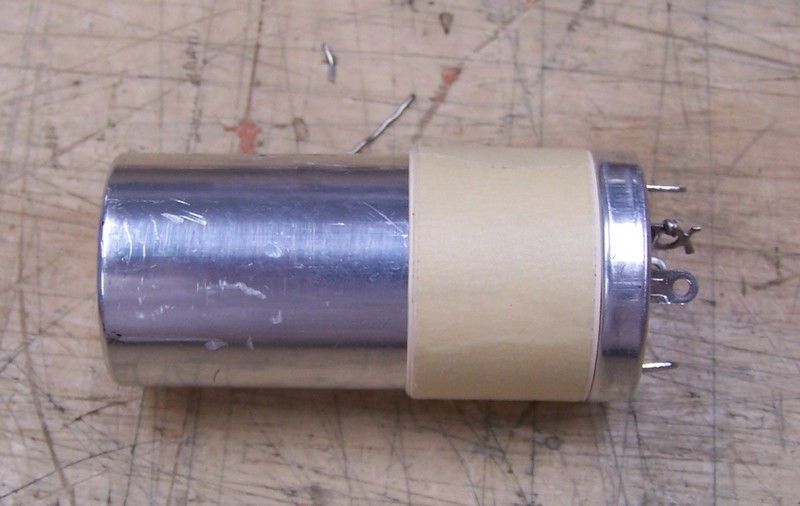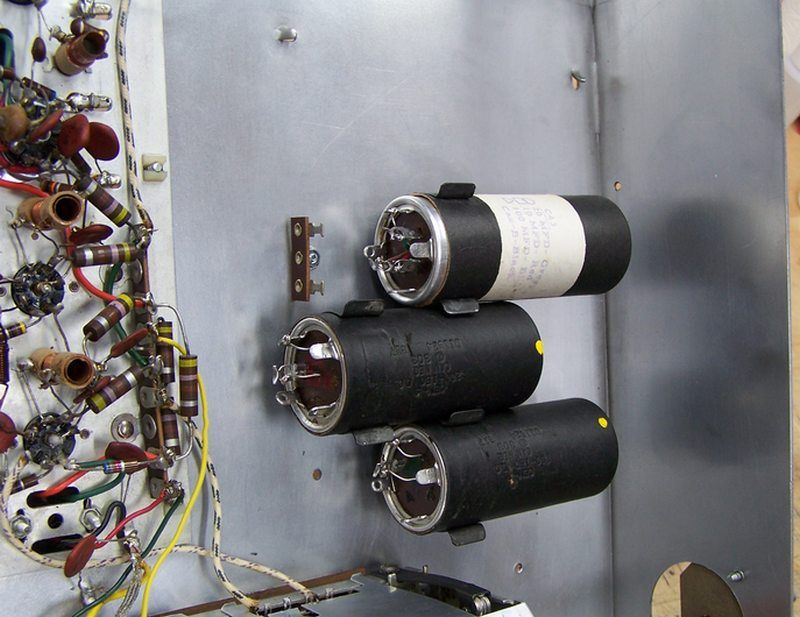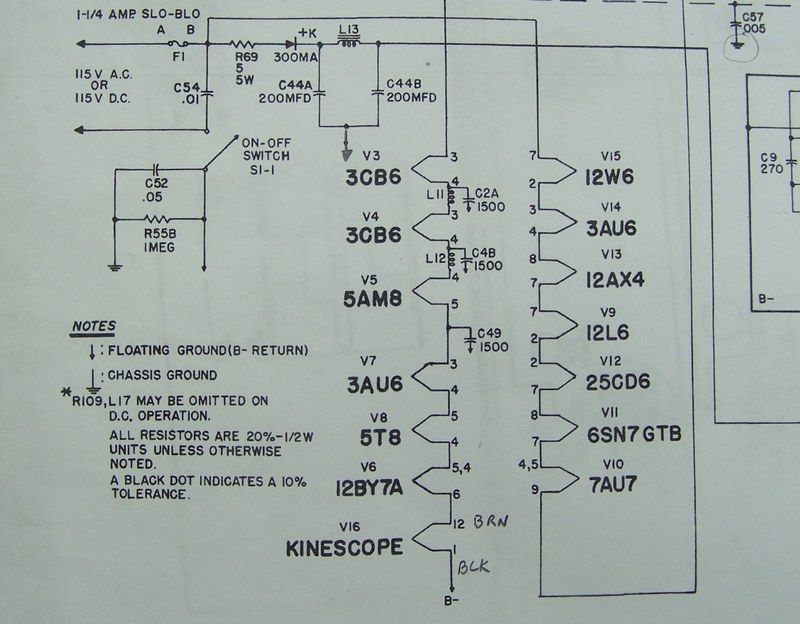
 |
|
#76
|
|||
|
|||
|
That would be kinda hard, seeing it's been cut in half. anyways I don't have any way to measure it.
|
|
#77
|
|||
|
|||
|
That is quite normal. Capacitor manufacturers would often use a can that was already stamped and stuff whatever they needed into it when they knew they were going to put a cardboard sleeve around it. I have seen it several times.
|
|
#78
|
|||
|
|||
|
I was thinking along the same lines. Remember this cap has never been installed, it is a part of the kit.
|
|
#79
|
|||
|
|||
|
I restuff my cans in much the same way. The only thing different is, instead of the PVC pipe, I use the thin aluminum salvaged from a beverage can.
I cut the can apart with kitchen shears and roll the metal up as a sleave, then I use silicone sealant to hold it all together. |
|
#80
|
|||
|
|||
|
Quote:
The label made on a spirit duplicator shows some real class. Reminds me of school days, where some weekly tests were ran off on them. The cap has a Sentinel part number from 1953.  I would use 22mfd for the 10, 47 for the 20 @250 volts and 100 @160 volts for the 100 section. BTW, Is there any truth to the theory that operating too high of a voltage rated 'lytic on lower voltage, IE a 450 volt cap at 150 volts, that they never seem to form properly, or just another urban tale. 
|
| Audiokarma |
|
#81
|
||||
|
||||
|
Quote:

|
|
#82
|
||||
|
||||
|
Quote:
Just the cap manufacturer "reclaiming" perfectly usable scrap from a previous production run, and using it where it presumably wouldn't be noticed. |
|
#83
|
|||
|
|||
|
Quote:
|
|
#84
|
|||
|
|||
|
Here is how I re-stuffed the E-Caps. Once the epoxy is dried, I attached some wires to each E-Caps, then used some hot glue to glue them together. I routed the wires together and secured them with some string tie. Then they were inserted through the hole and hot glued into place. Then the wires are soldered to each terminal.
I then slid on the can and fixed it into place with some clear tape. Then I wanted to increase the diameter of the can because the cardboard tube is a larger diameter that matches the base. This was done so when the E-Cap is inserted into the clamp, the cardboard tube is not crushed. I used some masking tape and manilla folder stock. Then the tube is slid over the whole assembly. No glue is required here because of the clamp method of mounting. The E-Caps were then inserted into their proper clamps. I did re-position TB20 by turning it 90 degrees to give me more room between TB20 and C43.    
|
|
#85
|
|||
|
|||
|
I do think that completes all the "prep" work I wanted to do before assembling the kit.
I still need some caps which are on order and should be here this coming week. |
| Audiokarma |
|
#86
|
||||
|
||||
|
It is kind of interesting that the kit came with all the tube sockets and terminal strips riveted in place. With Heathkits and Eico kits, the mechanical assembly was left to the kit builder, using screws and nuts, rather than rivets.
On Eico gear, you can usually identify the factory wired units by the riveted components, vs. the screws used on the kit units. |
|
#87
|
|||
|
|||
|
Quote:
|
|
#88
|
|||
|
|||
|
I'm looking at the 115vac mains connection to the chassis.
Now I have to mention that the IF strip, Tuner, and all B- is floating above the chassis. The IF Strip and Tuner are mounted to the chassis using nylon "clip" nuts and the metal plate of the IF Strip and all the metal of the Tuner does not show continuity to the chassis. Here is a photo of the mains power part of the schematic. Resistor R58, 1 meg, goes from the "switched" side to the chassis. This is the only connection that I can see where the chassis is connected to the mains. C54 will be a Y2 safety cap, and C52 will be a Y2 safety cap. There are 2 more caps one from the IF Strip metal plate and one from the Tuner chassis that goes to the chassis. I'm guessing that these need to be Y2 safety caps too. In the schematic you can see one of them (C57 from the Tuner chassis to the chassis) in the upper R/H corner.  I've never worked on a hot chassis before, so my question is should I wire the hot leg to the switch and the neutral through the fuse and onto the rest of the circuit? Seeing it is AC does it really matter? Should I reconfigure the wiring to switch the hot leg and have it going to the fuse and onto the rest of the circuit? I do plan on using a polarized plug for the power cord. I won't be using the provided interlock cord though. Also I'll be using my isolation transformer with this chassis. Last edited by Crist Rigott; 12-11-2016 at 11:43 PM. |
|
#89
|
||||
|
||||
|
Proper practice would be to wire the neutral side DIRECTLY to B-, and run the hot side first to the fuse, then through the switch.
Yes, all the caps from B- to chassis need to be mains-rated types. |
|
#90
|
|||
|
|||
|
Here is another thought that I had. Would this TV benefit from a thermistor in the filament string? My mains are 122vac while the filament string adds up to 115vac.
Another question. In the tube data sheets they say the heater is surge is minimized during warm up. Most of the tube data sheet said this. What do they mean? Maybe I don't need a thermistor? Last edited by Crist Rigott; 12-12-2016 at 06:21 PM. |
| Audiokarma |
 |
|
|